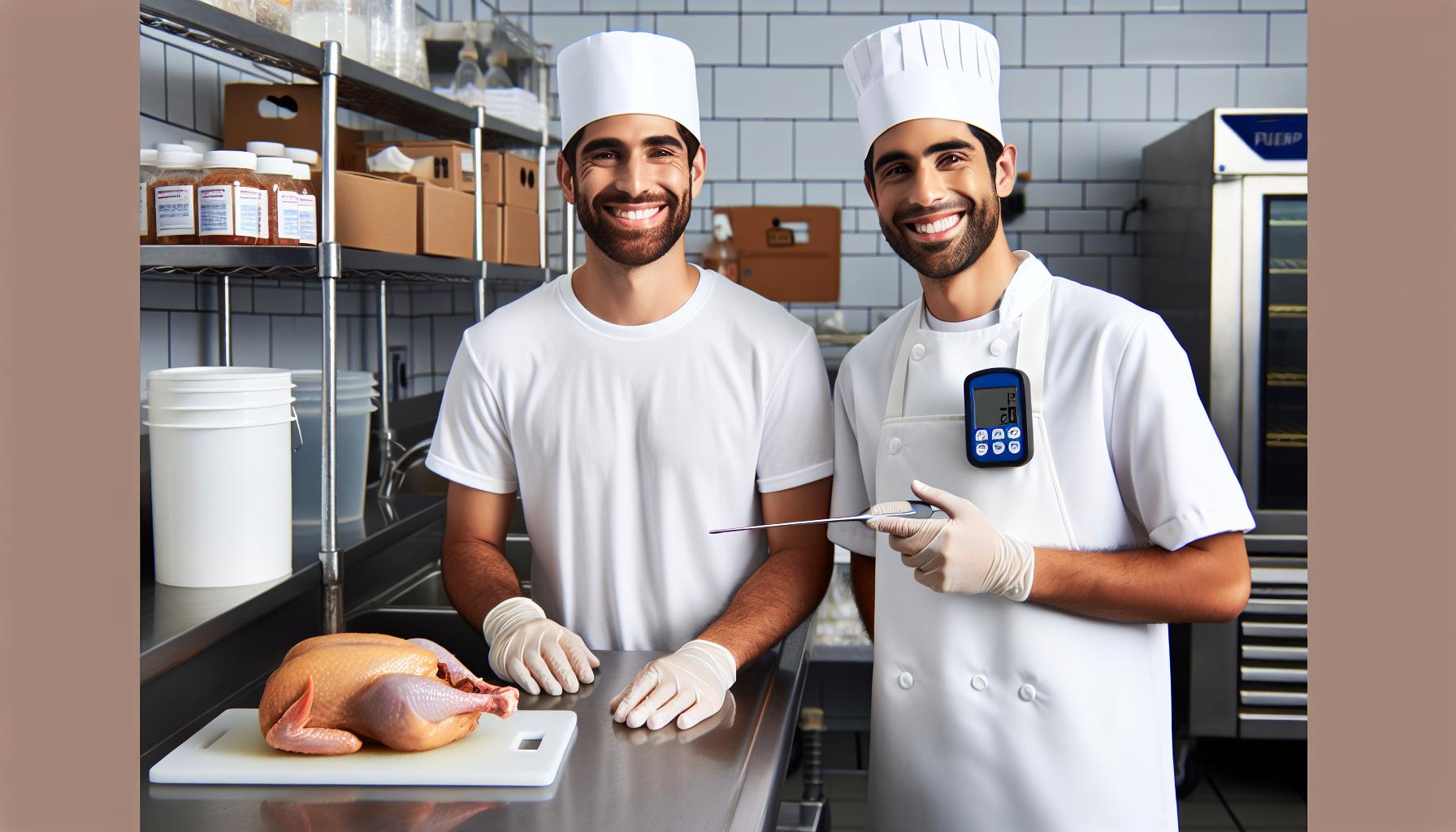
Food safety isn’t just about keeping your fingers crossed and hoping for the best. It’s a crucial aspect of working in the food service industry that requires proper knowledge and certification. Whether you’re a seasoned chef or a newbie server, passing your state food safety test is essential to keeping customers safe and your business compliant.
Getting ready for the food safety exam doesn’t have to feel like preparing for a root canal. With the right preparation and understanding of key concepts, anyone can master the fundamentals of safe food handling, temperature control, and proper sanitation procedures. From cross-contamination prevention to proper storage techniques, these vital skills help protect public health and maintain professional standards in food service establishments.
State Food Safety Test Answers
Food safety certifications establish mandatory qualifications for food service professionals across different jurisdictions. These requirements vary by state, county and specific job roles in the food service industry.
State-Level Food Handler Cards
Food handler cards validate basic food safety knowledge through state-approved testing programs. Each state maintains specific requirements, with California mandating cards within 30 days of employment, while Texas requires certification within 60 days. The cards cover essential topics:
- Temperature control for hot foods (135°F) and cold foods (41°F)
- Personal hygiene standards including handwashing protocols
- Cross-contamination prevention methods
- Cleaning procedures for food contact surfaces
- Proper food storage practices
ServSafe and Other Major Certifications
ServSafe certification represents the restaurant industry’s gold standard for food safety training. The program offers multiple certification levels:
| Certification Level | Valid Period | Cost Range |
|---|---|---|
| Food Handler | 3 years | $30-$45 |
| Manager | 5 years | $125-$165 |
| Alcohol | 3 years | $40-$60 |
Alternative certifications include:
- National Registry of Food Safety Professionals (NRFSP)
- National Environmental Health Association (NEHA)
- Prometric Certified Professional Food Manager
- 360training Learn2Serve Food Protection Manager
These programs align with FDA Food Code standards, providing comprehensive food safety education for industry professionals.
Key Food Safety Topics Covered on State Tests

State food safety exams assess essential knowledge areas that directly impact public health safety in food service establishments. The following topics represent core testing components across multiple state jurisdictions.
Temperature Control and Danger Zones
Temperature control stands at the center of food safety certification exams. Food enters the danger zone between 41°F and 135°F, where bacteria multiply rapidly. Hot foods maintain safety at 135°F or above, while cold foods remain safe at 41°F or below. Proper cooling requires food temperature reduction from 135°F to 70°F within 2 hours, then to 41°F within 4 additional hours. Time temperature logs document these critical control points to ensure compliance with state regulations.
Cross-Contamination Prevention
Cross-contamination prevention focuses on separating raw meats from ready-to-eat foods. Color-coded cutting boards designate specific food groups: red for raw meat, green for produce, yellow for poultry. Food storage follows a top-down arrangement: ready-to-eat foods on top shelves, raw meats on bottom shelves. Separate prep stations maintain distinct work areas for raw proteins versus produce. Equipment sanitization between different food types creates additional barriers against bacterial transfer.
Personal Hygiene Standards
Personal hygiene requirements establish barriers between food handlers and potential contamination sources. Food workers wash hands for 20 seconds using hot water at 100°F minimum. Double handwashing applies after restroom use or handling raw meat. Clean uniforms protect food from contamination, while hair restraints keep loose strands away from food prep areas. Food handlers stay home when experiencing fever, vomiting or diarrhea symptoms. Proper glove changes occur between tasks to maintain sanitation standards.
Common Questions on State Food Safety Exams

State food safety exams frequently test knowledge on critical food service operations through scenario-based questions. These questions assess practical understanding of safe food handling practices essential for daily operations.
Food Storage Guidelines
Food storage questions focus on temperature requirements temperature danger zones. Raw meats require storage below 41°F in sealed containers on bottom shelves. Dry goods need storage 6 inches off the floor in airtight containers at 50-70°F with 50% humidity. Storage duration limits apply to different food categories:
| Food Type | Refrigerator Storage | Freezer Storage |
|---|---|---|
| Raw Poultry | 1-2 days | 9 months |
| Ground Meat | 1-2 days | 4 months |
| Fresh Fish | 1-2 days | 6 months |
| Fresh Produce | 3-5 days | N/A |
Cleaning and Sanitizing Procedures
Proper cleaning involves a four-step process: scraping removing food debris washing with detergent rinsing with clean water sanitizing with chemical solution. Sanitizer concentration requirements vary by type:
| Sanitizer Type | Required PPM |
|---|---|
| Chlorine | 50-100 PPM |
| Quaternary Ammonium | 200-400 PPM |
| Iodine | 12.5-25 PPM |
Test strips verify correct sanitizer concentration. Contact time ranges from 7 seconds for chlorine to 30 seconds for quaternary ammonium.
Foodborne Illness Prevention
Foodborne illness prevention questions address common pathogens temperature control cross-contamination. Key prevention strategies include:
- Monitoring internal cooking temperatures:
- Poultry: 165°F
- Ground meat: 155°F
- Seafood: 145°F
- Following proper handwashing procedures:
- 20-second wash duration
- Hot water at 100°F minimum
- Hand sanitizer as supplement only
- Implementing allergen controls:
- Separate prep areas
- Designated equipment
Tips for Passing Your Food Safety Test

Successful completion of food safety certification tests requires effective preparation strategies focused on key food handling concepts. The following approaches maximize study efficiency while ensuring comprehensive knowledge retention.
Study Strategies and Resources
Food safety certification preparation starts with accessing state-approved study materials from official sources like ServSafe or state health departments. Digital flashcards create interactive learning experiences for essential terms such as temperature danger zones time requirements. Online video tutorials demonstrate proper handwashing techniques food storage procedures sanitization methods. Study groups enhance learning through peer discussion collaborative problem-solving focused on real-world scenarios. Professional training manuals offer structured content covering food safety principles allergen management cross-contamination prevention. Mobile apps provide convenient practice opportunities during breaks or commute times.
Practice Test Recommendations
Taking multiple practice tests familiarizes test-takers with question formats common scenarios time management requirements. Official practice exams mirror actual test conditions with similar question styles scoring methods time limits. Sample questions focus on critical areas:
- Temperature control ranges (41°F-135°F)
- Cross-contamination prevention procedures
- Proper handwashing steps sequences
- Food storage requirements specifications
- Sanitizer concentration measurements
Practice tests identify knowledge gaps requiring additional review before certification testing. Timed practice sessions build confidence in completing exams within allocated periods. Question banks rotate content preventing memorization encouraging comprehensive understanding.
Important Food Safety Regulations Updates
Food safety regulations undergo continuous updates to enhance public health protection in food service establishments. Recent modifications reflect evolving industry standards based on scientific research and emerging food safety challenges.
Recent Changes in Food Code
The FDA Food Code’s latest edition introduces significant updates to time-temperature control requirements. Raw animal products now require specific internal cooking temperatures: 165°F for poultry 155°F for ground meat 145°F for whole muscle cuts. Updated handwashing protocols mandate 20-second wash times with specific focus on cleaning between fingers nail beds. The code establishes stricter guidelines for date marking requiring facilities to track ready-to-eat foods stored over 24 hours at 41°F or below. New allergen management protocols include dedicated preparation areas separate storage containers color-coded utensils.
New State Requirements
California implements mandatory food handler certification renewal every 3 years with an 80% passing score requirement. Texas expands certification requirements to include all food service employees not just managers. Florida adopts digital temperature monitoring systems for cold storage units with automated logging requirements. Oregon mandates specialized allergen training for all food service workers. New York requires establishments to maintain detailed cleaning logs with sanitizer concentration readings. Illinois introduces enhanced requirements for mobile food vendors including quarterly inspections GPS tracking systems. These state-specific updates align with federal guidelines while addressing local food safety concerns.
Food Safety Certification
Food safety certification stands as a crucial requirement in the food service industry protecting both businesses and consumers. Staying current with state-specific regulations and understanding essential concepts like temperature control cross-contamination prevention and proper sanitization procedures is vital for success.
Test preparation doesn’t need to be overwhelming. With dedicated study using state-approved materials and a focus on practical application food service professionals can confidently approach their certification exams. Taking advantage of available resources and maintaining updated knowledge will ensure continued compliance with evolving food safety standards across all states.


